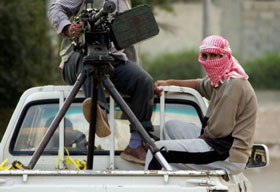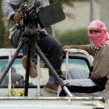Al-Qaeda’s Insurgency Doctrine: Aiming for a “Long War”
Publication: Terrorism Focus Volume: 3 Issue: 8

Conventional national militaries train, think, and fight according to their doctrine. To date, however, America and the West have not sufficiently appreciated that al-Qaeda, too, is fighting the insurgencies in Iraq and Afghanistan according to a doctrine of its own. That doctrine has been developed from the group’s experiences during the Afghan war against the Red Army, and has matured through each of the insurgencies in which bin Laden’s fighters have since been involved, from Eritrea to Xinjiang to Mindanao. In presenting their doctrine, al-Qaeda’s strategists also have tipped their turbans to the significant lessons they have learned from Sun Tzu, Clausewitz, Mao, General Giap, and even Ahmed Shah Masood, as well from the training manuals of the U.S. and UK Marines and Special Forces. Ironically, al-Qaeda strategists have discussed all of these matters for years in their Internet journals, but this discussion has garnered little interest in Western essays.
The corpus of al-Qaeda’s writings on the development and application of its insurgency doctrine is too diverse and voluminous to discuss in a single article. For present purposes, it will suffice to look at some of the insurgency-related work of five of the group’s strategists: the late Abu-Hajer Abd-al-Aziz al-Muqrin, Abu Ubyad al-Qurashi, Abu-Ayman al-Hilali, Abd-al-Hadi, and Sayf-al-Din al-Ansari. These writings discuss the need to conduct the political and military facets of an insurgency in tandem. They are especially worth reviewing now because of the success al-Qaeda is having in using its doctrine against U.S.-led forces in Iraq and Afghanistan, a success that has prompted U.S. Defense Secretary Rumsfeld to rename the Global War on Terror as the “Long War” and to publicly lament that al-Qaeda is beating the U.S. in the political war being fought in the media. The essays used herein to analyze al-Qaeda’s insurgency doctrine were published between January 2002 and February 2004 in the al-Qaeda Internet journals al-Ansar, al-Neda, and Mu’askar al-Battar.
Al-Qaeda Doctrine in Iraq and Afghanistan: The Military
Religious obligation is the central point on which al-Qaeda’s insurgency doctrine was and is grounded. Osama bin Laden and—since the U.S.-led invasion of Iraq—hundreds of Islamist leaders and clerics have declared a “defensive jihad” against the United States, a form of jihad that mandates the participation of every Muslim through taking up arms, financial donations, prayer, providing safe haven, or some other form of support. This is what Abu-Hajer Abd-al-Aziz al-Muqrin called the “First Axis of Jihad,” the axis that requires complete victory over the infidels, a goal that “is not subject to discussion” and which permits “no half-solutions” and “no-bargaining.” In this form of jihad, however, bin Laden and al-Qaeda’s strategists have firmly declared that universal participation does not mean that each Muslim acts on his or her own, but rather they act in unity with other Muslims. “A feeling of [individual] responsibility,” Sayf-al-Din al-Ansari explained, “does not mean embodying jihad in scattered individual actions. The feeling needs to be deepened by striving for well-planned actions emanating from a position of collective activity.”
This “collective activity” is what al-Muqrin termed the “Second Axis of Jihad,” the one that covers military strategy and operations, and features a doctrine that is “flexible,” “depends on conditions and circumstances,” and can easily “accept half-solutions.” This adaptability among the mujahideen,” Abu-Ubayd al-Qurashi wrote, “is done on the basis of practical experience and field results. This means that jihad military doctrine is constantly changing, thus denying America the chance to know it well or train its troops on how to confront it decisively and permanently.” As important, Abu-Ayman al-Hilali wrote, the insurgents’ doctrine must address all aspects of the country and society in which the war is being fought. “[W]orking in an organization dedicated to jihad,” al-Hilai argued, “requires a fundamental working knowledge of planning, administration, security, psychology, sociology, history, geography, politics, strategy, law, education, preaching, and military science, not to mention religious knowledge.”
In terms of fighting the U.S.-led coalitions in Iraq and Afghanistan, Muqrin spoke for each al-Qaeda strategist when he explained that Islamist forces must be prepared to fight a “long war of attrition,” a struggle in which “the enemy of God will feel that it is impossible to finish off the mujahideen’s military power.” In both the Iraqi and Afghan “arenas of jihad,” the overriding goal for mujahideen leaders should be to prepare to fight the mightiest military power on earth; the insurgent leadership, Muqrin advised, must “know the enemy it is fighting.” The mujahideen chiefs must be “psychologically prepared for the worst” and, on this basis, they must build an organization “so if one link falls, whatever its organizational size is, the organization [as a whole] does not suffer lethal blows.” Before widespread attacks began, Abd al-Hadi added, it was essential that leaders conduct extensive “reconnaissance and surveillance operations to find the enemies’ weak points,” as well as to “build a vital [dynamic?] database on each target, as well as every change in enemy movements in all regions [of the country] before taking any action.”
When military operations based on this data are ready to begin, Muqrin urged the mujahideen to follow “the 1,000-wound” policy of guerrilla war with the goal of prolonging the war to “exhaust” the enemies’ patience and resources, and to avoid set-piece battles and attacks on “hardened targets” that would be too costly in terms of mujahideen casualties. “We can exhaust him [the enemy],” Abd-al-Hadi wrote, “without fighting any real battles with him.” Al-Qaeda’s strategists believe that they could find no better foe than the Americans against which to implement this doctrine. The Americans love “fixed bases,” al-Qurashi argued, and even in the field their combat forces are awkward, with troops who are “highly paid and overloaded with comfort facilities that often restrict their movements.” The key to victory lies in a simple reality, Muqrin noted, American bases are “known and immovable,” while those of the mujahideen are “light and movable.”
Al-Qaeda Doctrine in Iraq and Afghanistan: The Media
Among the strategists referenced in this article, the Saudi al-Muqrin most thoroughly discussed the essential interconnectedness of the military and media dimensions of insurgency. Muqrin argued that the military and media campaigns must be accelerated simultaneously. While al-Qaeda’s military doctrine required that the mujahideen wage war in all areas of Afghanistan and Iraq, this widespread activity was no less essential from the perspective of influencing the Muslim and Western worlds. “[There must be] no trace of doubt left on anybody’s mind that they [the mujahideen] are present all over the land,” Muqrin explained. “This will prove the mujahideen’s power, rub the nose of the enemies in the dirt, and encourage young men to take up arms and face the enemy—Jews, Christians, and their collaborators.” Such demonstrations, moreover, will stimulate donors to increase funding for the mujahideen. This is vital, Muqrin noted, because “jihad eats up enormous funds” and those funds are “the nerves of the jihad.” In addition, broad and continuous mujahideen military activity will send a warning “through the language of blood or fire” to the people of nations allied with America that “their governments are getting them involved in wars and conflicts with which they have nothing to do.”
Conclusion
The insurgency doctrine used by al-Qaeda has been evolving for more than a quarter-century, and is designed to defeat conventional Western military forces. It calls for the group’s fighters to be able to fight in the mountains, in desert regions, in maritime conditions, and to be able conduct what Muqrin refers to as “covert action” in urban areas. These multifaceted military operations must be matched by the mujahideen “excelling in their organized media action.” Tellingly, however, al-Qaeda’s insurgency doctrine pays virtually no attention to what the West would identify as “terrorist” operations. While such attacks, Muqrin wrote, are an essential contribution to the mujahideen’s war effort—especially “qualitative operations” like those of 9/11—they are best left to other units of the al-Qaeda organization.




